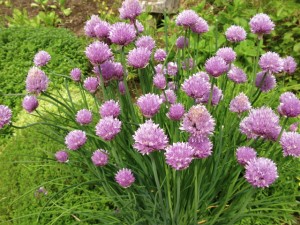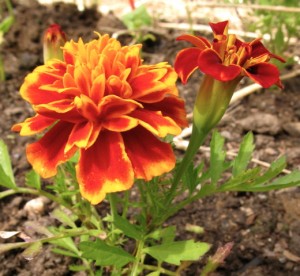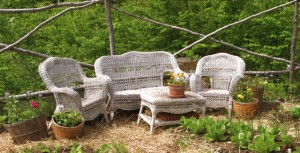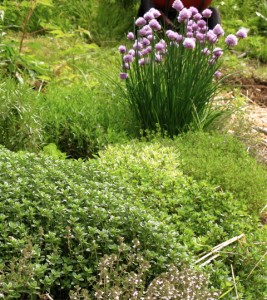Companion Planting in the Organic Vegetable Garden
 Chives and thyme in the potager
Chives and thyme in the potager
Companion planting is a very old-world, organic gardening method. Unfortunately, much companion planting knowledge has fallen out of use and favor in modern times due to a focus on efficiency. Of course on large farms efficiency is very important, but in a home garden I prefer to concentrate as much on process as I do on product. Instead of rotor-tilled planting strips, I have raised beds of mounded earth in my potager. My vegetable garden is organized in wide planting groups, not narrow rows. This sort of arrangement is not practical for commercial growers, but in a back yard vegetable garden, it works beautifully. From a design stand-point, I like this method of vegetable gardening because it maximizes my space, and allows me to create whimsical-looking arrangements of flowering and fruiting plants. There are also more practical and scientific benefits to this shared-space arrangement as well. Mixed-vegetable beds with herbs and flowers create many opportunities for synergistic relationships between plants. Utilizing natural plant relationships is one of the oldest organic gardening methods for vegetable growing success.
 Calendula, (marigold)
Calendula, (marigold)
Herbs and flowers make attractive companions to vegetables, and many decorative potager plants lure beneficial insects. Blooming, fragrant herbs and flowers appeal to insects such as bees, green lacewings, hover flies, and lady bugs, among other helpful creatures. Yarrow is a pretty garden flower, and morning glory vines look beautiful growing up a garden fence. More importantly, and worth noting: these plants attract lady bugs and other insect-carnivores. Wild flowers, such as golden rod, are often mown down or uprooted by gardeners as ‘weeds’, but these flowers attract parasitic wasps, assasin bugs and lady bugs as well. Keeping native wild flowers around is a good idea for the organic gardener, as these plants are natural magnets for beneficial insects. Many insect-helpers eat pollen, and they are attracted to blooming plants during their adult stages. Later their off-spring, in the larval stage, will devour aphids, thrips, white flies, mealybugs, and many more pests. For useful information on how to identify friend from foe, visit sites in the entomology -links section to the right of this post on the blog-roll.
Attractive potager plants make the vegetable garden a beautiful and pleasant place to work and many are flavorful additions to recipes. However not all living things enjoy the presence of pungent herbs and flowers. These plants can also serve to repel insects and to mask the odors of more attractive plants, confusing or distracting pests. Onions, chives and garlic tend to deter aphids, ants and flea beetles. Rosemary may be flavorful to humans, but it is an unattractive, powerful scent to carrot flies and cabbage moths. Calendula, (marigold), is a traditional French potager plant used ward-off aphids, white flies and potato beetles. French marigold is also a deterent to nematodes and tomato hornworm. Basil and borage are also unappealing to tomato hornworm, and basil in particular makes a great edging plant for tomatoes. Surrounding tomatoes with basil may fool insect pests by masking the attractive odor of the tomatoes. Sage deters carrot fly and it also is unappealing to cabbage moth, as is thyme, hyssop and artemesia.
Companion planting also utilizes the harmonious and beneficial relationships between the plants themselves. Some crops, when grown near one another, may grow and yield better, and also protect one another from insect pests. Native Americans developed companion planting schemes based on such experiences; growing pole beans with corn for support, and surrounding corn with squash to deter raccoons, (apparently they dislike climbing over the leafy plants). Clearly it is important to plant taller or larger-growing crops, (like corn, pole beans and pumpkins for example), in beds where they can spread out and up without blocking sun, or smothering smaller crops near-by.
Most gardeners love to grow tomatoes. Herbs like parsley, basil, mint and chives are all good companions for tomatoes. Â Flowers, such as nasturtium, marigold, and bee-balm also make good neighbors for tomatoes of all kinds. Lettuce grows well at the foot of tomato plants, and cucumbers, celery and chili peppers are happy near-by, (with proper spacing of course). Keep in mind that tomatoes, eggplant, bell pepper and potatoes should not be grown directly next to one another, as they all attract Colorado potato beetle. When planting these plants, mix them up with other plant groups, like herbs and lettuce. Another planting combination to avoid is tomatoes and corn, as they both attract a pest known by two names: corn ear worm/tomato fruit worm. Try planting tomatoes and corn at opposite corners of the garden to deter these pests.
Pole beans are also popular potager plants, and in general they will do best planted away from members of the cabbage family, (broccoli, cauliflower, cress, kale, mizuna, arugula, radish, turnip, brussel sprouts). However most bush-beans are not so picky. All beans do well mingled with rosemary and celery, but should not be next-door-neighbors with fennel, basil and onion.
Cucumbers, another back-yard favorite, are a rewarding, fast-producing crop. They grow well near bush beans, eggplant, cabbages, peas, tomatoes lettuce and all herbs except sage. Â It is wise to avoid planting cucumbers near potatoes, and also provide separation between this plant and squash, pumpkin and melon, as they are all host to the stem and fruit boring pickle worm.
Summer squash and zucchini are also popular garden crops, and they make great companions for onions, radishes, and corn and celery. Â But as mentioned above, this plant is best grown away from cucumber and potatoes, to deter pests.
Head lettuce grows well beside most vegetable plants, and it does particularly well in mid-summer near taller plants, as they give the lettuce a bit of shade. Pole beans or peas provide an excellent opportunity to test this synergistic relationship. Because lettuce is a fast growing crop, benefitting from cool conditions, it can be sown at the feet of many vegetables through out the growing season.
These planting suggestions are best viewed as guides, not hard and fast rules. There are many, many more plant relationships to explore.  Research companion planting online, and in some of the books mentioned on this site in the ‘Bookstore / Library’ (page left), under the ‘vegetable garden’,(last section). Try keeping a journal of your garden to note your experiences with companion planting, and to help you plan your garden next year. Remember that synergistic plant relationships can help reduce the need for insecticidal soaps and other pesticides. Above all, keep in mind that vegetable gardening is good for you in many ways. Experimenting with the beauty and benefits of herbs and flowers can only help you to enjoy companion planting as part of your overall garden experience.
 Newly planted flower baskets in this year’s potager will attract beneficial insects
Newly planted flower baskets in this year’s potager will attract beneficial insects
 Thyme, rosemary, savory and chives at the vegetable garden entry
Thyme, rosemary, savory and chives at the vegetable garden entry
Article copyright 2009 Michaela at The Gardener’s Eden. All rights reserved.
***
13 Replies to “Companion Planting in the Organic Vegetable Garden”
Comments are closed.
I have been looking looking around for this kind of information. Will you post some more in future? I’ll be grateful if you will.
Hi Gary, Thank you for your comment. I will be covering a wide range of topics on The Gardener’s Eden, and I am very interested in reader requests. My goal is to strike a balance between garden science and art. Thank you for following the blog. I hope to hear from you again !
-Michaela
Hello. I think the article is really interesting. I am even interested in reading more. How soon will you update your blog?
Thank you Konstantin. I update my blog weekly, sometimes even more, as time permits. I aim to balance science with art on this blog. So, sometimes the article will focus on organic gardening methods and maintenance or horticulture topics and sometimes the subject will be geared toward design. I hope you continue to enjoy it. – M
Hi,
well written article, I think our views on Companion Planting in the Organic Vegetable Garden differ a little however you put foward some good points
Thanks
I know this is really boring and you are skipping to the next comment, but I just wanted to throw you a big thanks – you cleared up some things for me!
I just couldnt leave your website before saying that I really enjoyed the quality information you offer to your visitors… Will be back often to check up on new stuff you post!
Just wanted to say great post. Just grabbed your RSS feed- looking forward to your future posts :)
I have really enjoyed your site and looked at every single picture. You have helped me get a perspective I just didn’t “get” before. Thanks. Please post more.
Eve